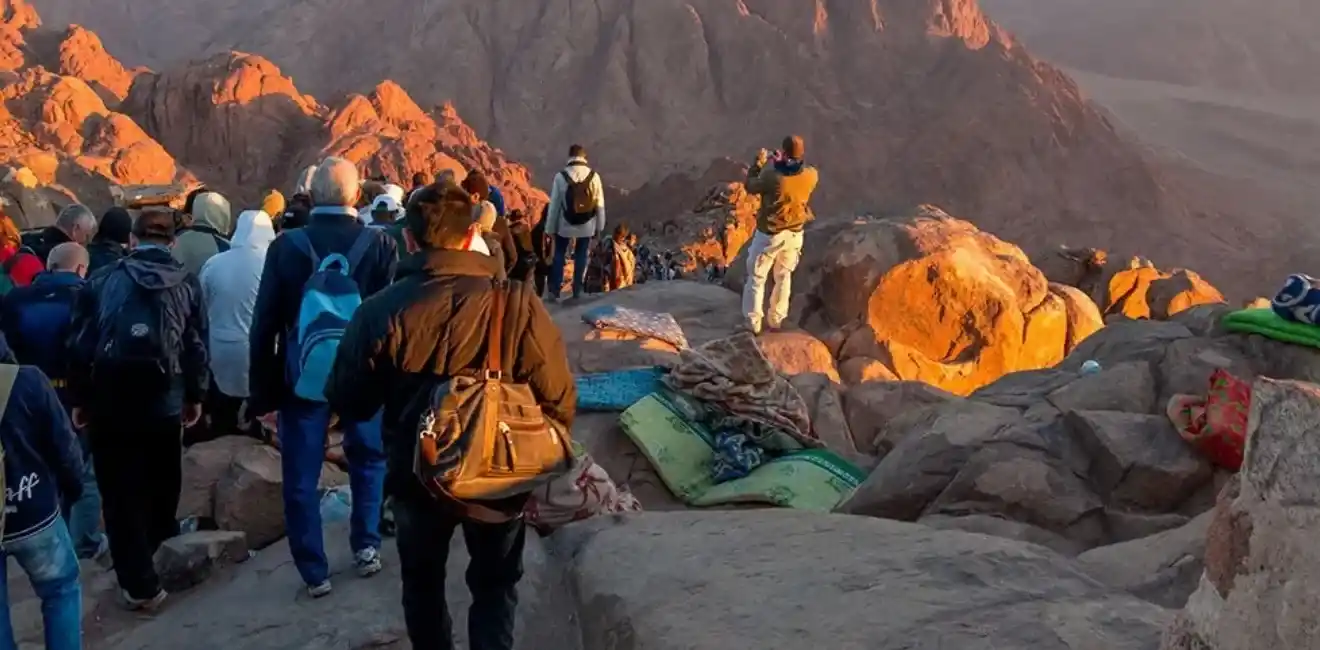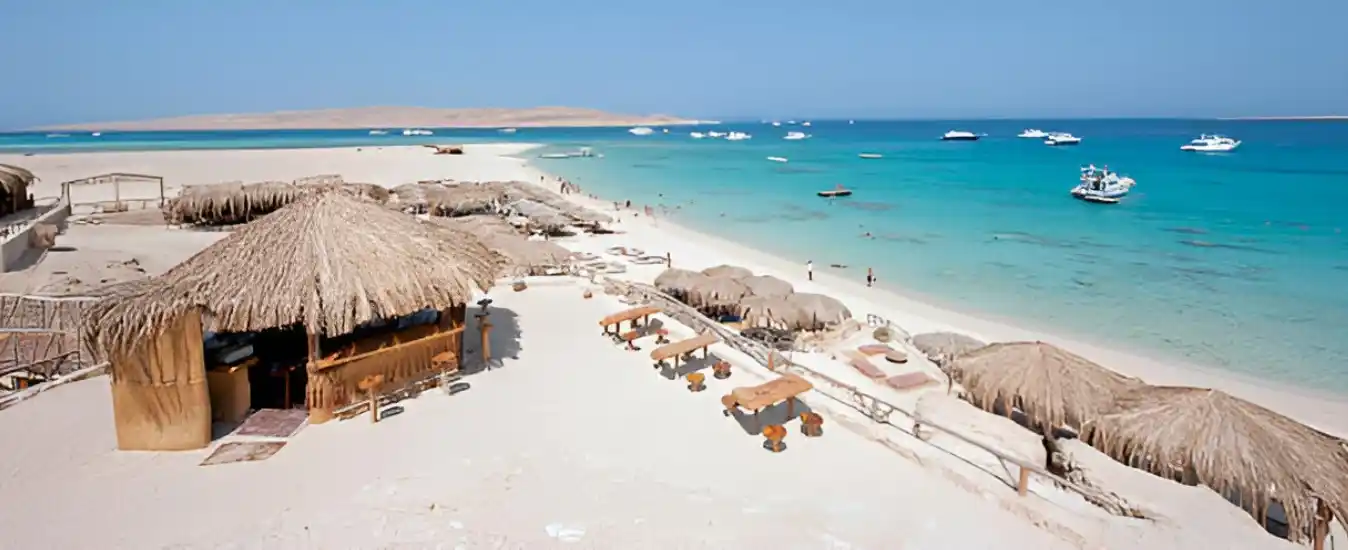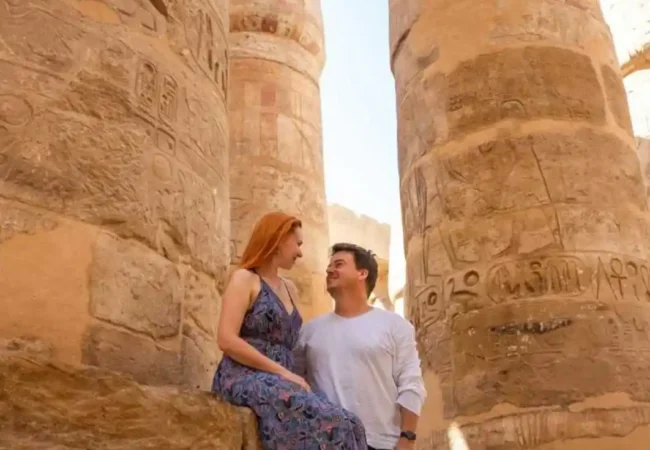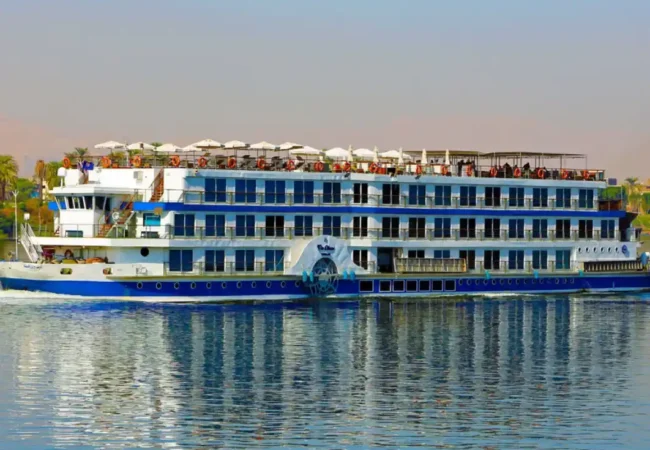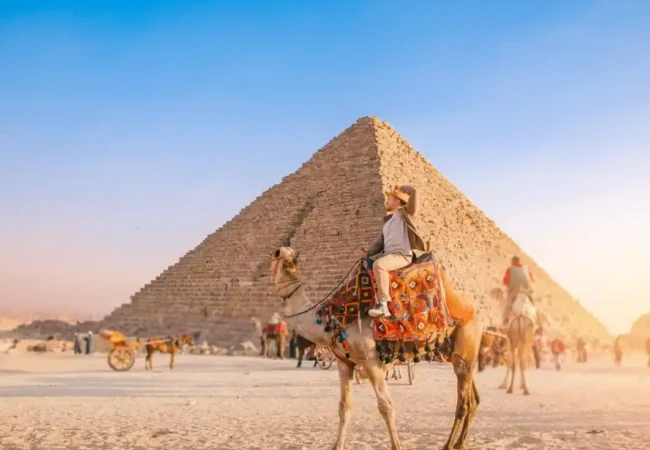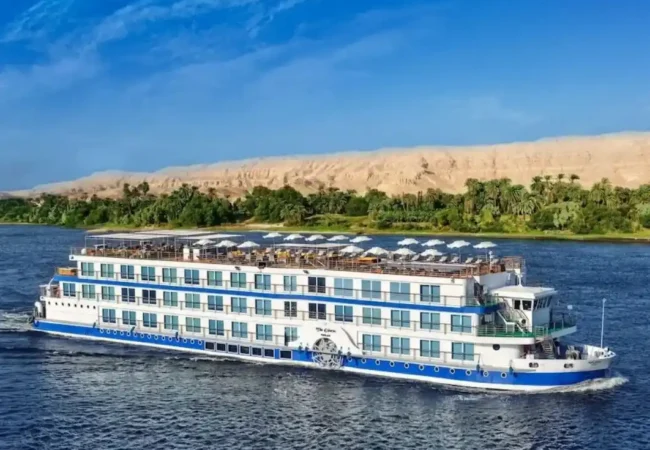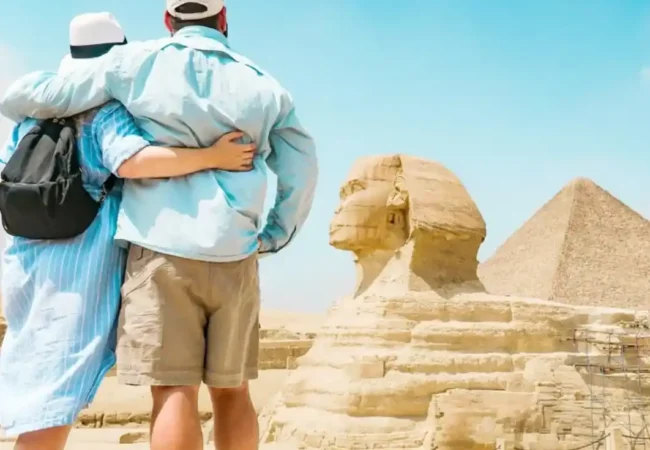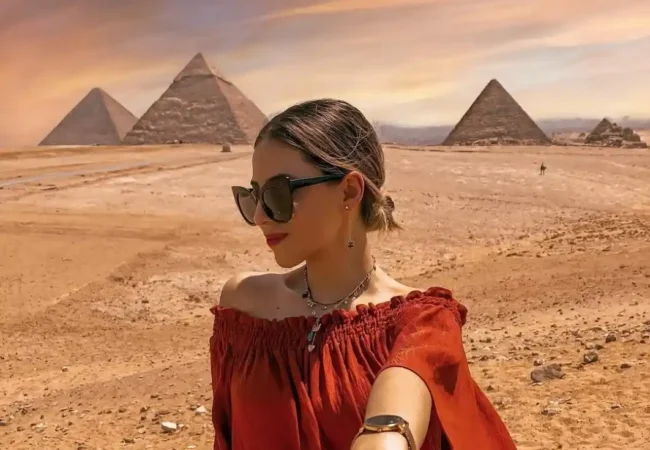
Khafre Pyramid: Unlock the Enchanting Secrets
Standing as one of the most iconic structures of Ancient Egypt, the Khafre Pyramid is a sight to behold. Built over 4,500 years ago, it is the second largest of the three pyramids of the Giza Necropolis or as it’s called Giza plateau and is an awe-inspiring testament to the architectural brilliance of the Ancient Egyptians.
The Pyramid of Khafre is the second-largest pyramid on the Giza Plateau and is known for its impressive architecture and historical significance. Surrounding the pyramid are the Temples of Khafre, which once served as important ceremonial sites connected to ancient religious practices.
These temples featured life-size statues of the pharaoh, crafted to honor his divine status and ensure his presence in the afterlife. The combination of towering stonework and detailed sculptures reflects the grandeur and spiritual importance of Khafre’s reign.
Located just 8 miles from the center of Cairo, it is an easy day trip for anyone wishing to explore the wonders of Ancient Egypt. Here, you will find an in-depth guide to visiting the Khafre Pyramid, from what to expect when you arrive to the best ways to explore the area and uncover its secrets.
Jump To
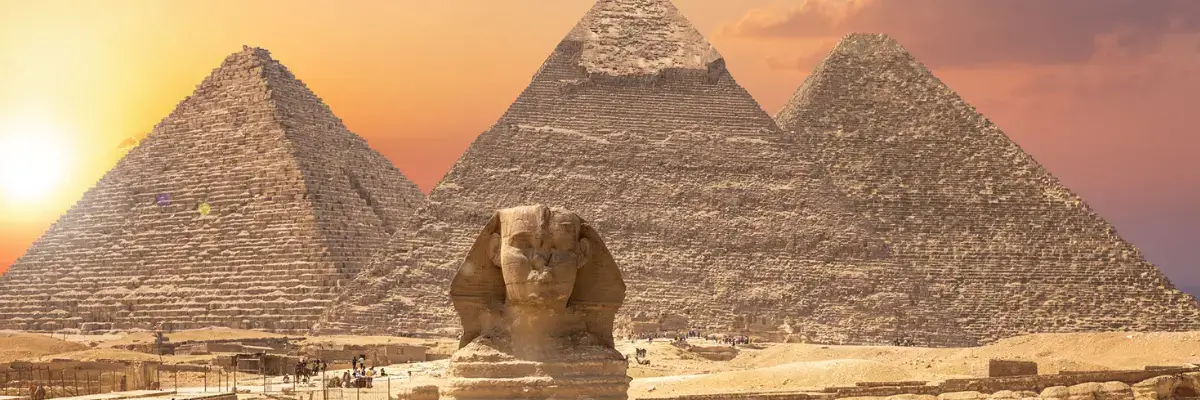
If you have visited the Giza Pyramids, you will have noticed that the Khafre Pyramid is a different structure to visit. It is, however, very easy to visit the Khafre Pyramid, as it is located just 8 miles from the center of Cairo. There are two main approaches to visiting the Khafre Pyramid, depending on how long you have in Cairo and your budget.
The first approach is to stay overnight in Cairo, and the second is to visit the Khafre Pyramid in a day trip from Cairo. Both options offer the best way to visit the Khafre Pyramid, as well as the other major sights of Giza, but it is based on how you want to spend your time in Cairo.
Exploring the Pyramid Complex
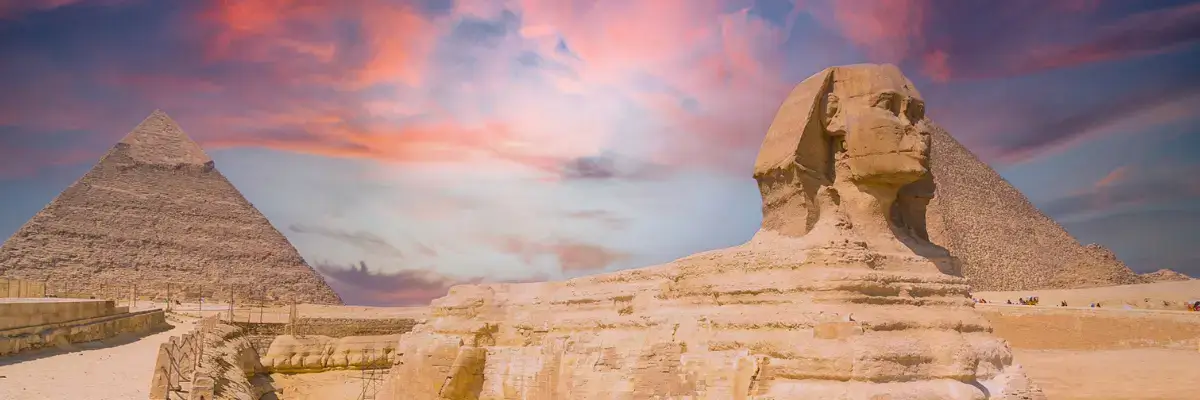
Visiting the Khafre Pyramid does not just mean climbing the pyramid itself. As the second largest of the pyramids in the Giza Complex, it is also home to a vast complex of temples, pyramids, and tombs. The major temples of the complex are the Great Hypostyle Hall and the North Temple.
The Great Hypostyle Hall is the largest and oldest of the temples of the Giza Complex, constructed around 2630 BC. The North Temple, meanwhile, was constructed around 2550 BC, and is the place where archaeologists believe the Great Sphinx of giza to be buried. Other temples of the complex are the Khan, the Queen, and the King’s. The Khan Temple was built next to the Great Pyramid and was dedicated to the king’s funerary cult.
The Queen’s Temple was built next to the King’s Pyramid and was dedicated to the queen’s funerary cult. The King’s Pyramid and the associated temples are the final resting place of Pharaoh Khufu.
There are also a number of tombs and burial structures within the complex. Perhaps the most important of these is the Mortuary Temple of the Great Khufu, an enormous structure built for Khufu’s burial and dedicated to the god Anubis.
Inside the Pyramid
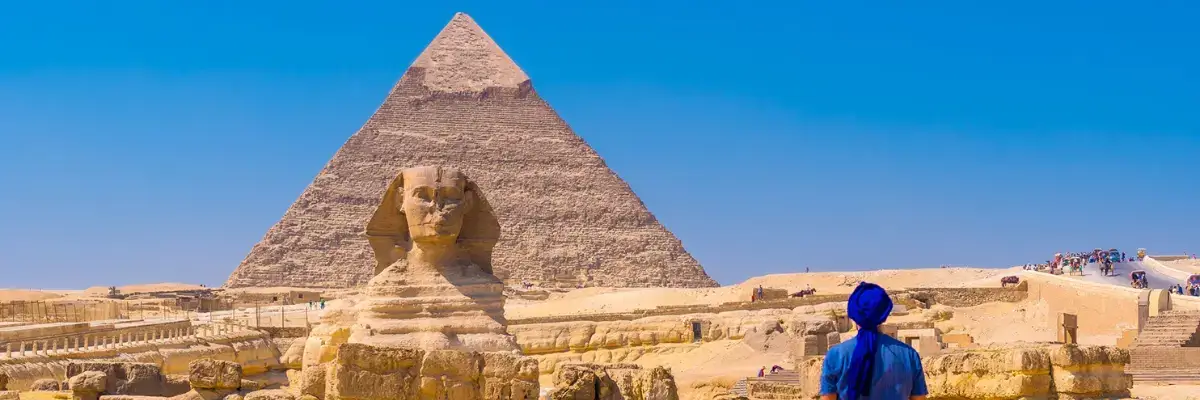
While climbing the pyramid will not take you inside the pyramid, it will give you a chance to explore the interior of the Khafre Pyramid. The interior of the pyramid is not as impressive as the exterior, but it does give you a chance to explore the Great Pyramid of Giza and its ancient function. Inside the pyramid, you will find the burial chamber of Khufu, which does not reveal much about its original function.
The interior of the pyramid, however, is intricately carved, and it is possible to explore the walls and ceiling. The interior of the pyramid is not accessible to the public, but you can go on a guided tour of the interior of the pyramid with your group or on your own by booking a private tour.
Who was Khafre?
King Khafre was one of the rulers of the Fourth Dynasty, the son of King Khufu by an unknown mother. He ruled Egypt after his half-brother, King Djedefre, for a period often cited as around 24 to 26 years, between approximately 2558 and 2532 BC.
The king married more than one woman, the most famous of whom was Queen Khamerernebty I, and fathered more than 12 children. His reign was characterized by prosperity and development in all fields.
Khafre provided Egypt with numerous achievements during his reign in the political, economic, and religious fields, such as the construction of the Pyramid of Khafre, which demonstrates the innovations of architectural art in ancient Egypt.
He also built the Great Sphinx statue next to the pyramid, a statue with the body of a lion and the head of King Khafre. In addition, he improved the economic situation through trade, agriculture, and the construction of engineering projects.
The Pyramid’s Interior Design, Entrances, and Burial Chamber
The Pyramid of Khafre has two entrances located on the north side of the pyramid. The first was built at a height of about 12 meters above the pyramid’s base, while the second was built at the base level. The entrances include numerous corridors adorned with inscriptions and drawings, which end in the burial chamber.
The burial chamber is the largest room in the pyramid, rectangular in shape with dimensions of 14.15 x 5 meters. It was carved into the pyramid’s rock, and its ceiling was built of limestone. It contains a sarcophagus made of massive black granite. Inside, only the bones of a bull were found, as one of the symbols of religious beliefs in funerary rituals. However, the pharaoh’s mummy has not been found to date.
There was a dedicated chamber for storing all of the king’s belongings, such as offerings, burial tools, accessories, and food and drink for use in the afterlife. It was equal in size to the burial chamber. As for the pyramid’s ceiling, it was constructed by carving gabled limestone rocks.
The Valley Temple
The Valley Temple is part of the pyramid complex of Khafre. The temple is located on the eastern side next to the Pyramid of Khafre. The king built it as a temple dedicated to the funerary rituals for his and his family’s burial. Its purpose was to perform purification rituals on the bodies of the deceased and then the mummification process in preparation for transferring them to the Mortuary Temple for the final religious burial rituals before moving to the sarcophagus inside the pyramid.
The temple has two entrances, one to the north and the other to the south, because the king’s burial rituals were performed as king of the North and also as king of the South. Deep inside the temple, there are a large number of statues of King Khafre.
The temple is distinguished by its architectural construction; the corners of its walls were built in an L-shape, and the temple floor was adorned with alabaster covered with red granite. The ceiling and columns were made of large stones that helped preserve it over the past years.
Khafre’s Pyramid Complex
Some believe that the pyramids were only the tombs of kings, dedicated to burying the king’s body, his treasures, and his needs for the afterlife according to ancient Egyptian beliefs. But in reality, the pyramids were one element among up to 14 elements of a pyramid complex, which was considered the king’s tomb. Some elements might be added or omitted between one pyramid complex and another, depending on the economic resources and the time taken to build the complex.
Khafre’s pyramid complex consists of several important elements, the most important of which are:
- The Pyramid of Khafre: It served as the king’s palace in the other world, used as his tomb where everything he needed to live in the afterlife was buried, according to Egyptian beliefs.
- The Valley Temple: In this temple, the mummification process and special prayer rituals were held. Inside, there were several statues of King Khafre and the god Horus.
- The Mortuary Temple: Inside this temple, the final religious rituals were performed on the king’s body after his mummification, after which he would be moved to his final resting place inside the Pyramid of Khafre.
- The Causeway: A road connecting the Valley Temple and the Mortuary Temple, which has many inscriptions.
- The Great Sphinx: Considered part of the complex, it was built to enhance the religious authority of King Khafre.
- Statue of King Khafre: The statue depicts King Khafre sitting on the throne of Egypt with powerful lions and the god Horus behind him, thus showing the king’s great reverence for this god.
Solar Boat Pits
The solar boat pits are among the most recent discoveries within the pyramid complexes. They were discovered by Egyptian archaeologists in 1954 next to the southern base of the Pyramid of Khufu, where there were two pits containing the main parts of disassembled boats carved from cedar wood. The boats were reassembled over a period of 10 years and became known as the solar boats.
From the inscriptions and images on the boat’s wood, it became clear that the boats were used for rebirth and were called funerary boats, according to ancient Egyptian beliefs. There were hieroglyphic writings on parts of the boat with the names of the Egyptian workers, in addition to 10 cartouches bearing the name of King Djedefre (Khufu’s successor), not Khafre.
Remnants of the Outer Casing on the Pyramid
The Pyramid of Khafre is distinguished from the Pyramid of Khufu by the presence of remnants of its polished outer casing. The finest type of limestone, smooth white limestone that reflects sunlight, was used to coat the pyramid’s exterior, which has helped preserve its outer casing.
Robbery of the Pyramid in Ancient Times
The Pyramid of Khafre still holds many unknown secrets. Since archaeologists discovered the pyramid in modern times and saw the burial chamber, they have confirmed that it had been robbed in the past. The stolen items included the pharaoh’s mummy and the offerings and archaeological treasures in the burial chamber.
The pyramid was robbed in ancient transitional periods, a few hundred years after the king’s death, specifically during the First Intermediate Period about 4,000 years ago. This period was known for its chaos, during which many pharaohs’ mummies were stolen.
Rediscovery of the Pyramid by Giovanni Belzoni
Giovanni Belzoni was the first to explore the Pyramid of Khafre in the early 19th century. He discovered its northern entrance and explored the rest of the chambers up to the burial chamber, where he found only a broken sarcophagus and the remains of bull bones. The Arab historian Ibn Abd al-Salam had confirmed that Arabs had explored the tomb in ancient times and found nothing in it.
Belzoni later made several other discoveries at Egypt’s archaeological sites, including the temple of Abu Simbel, Karnak Temple, and the tomb of Seti I. Many other discoveries followed in the Giza pyramid area by William Howard Vyse and John Shae Perring at the Pyramid of Menkaure.
The Relationship Between the Pyramid and the Sphinx
The Great Sphinx was discovered in the early 19th century and is one of Egypt’s most famous statues located within Khafre’s pyramid complex. It is located to the east of the pyramid, stands 20 meters high, and is 73 meters long. It is believed that 100 workers participated in its construction, completing it after 3 years.
The Sphinx statue is made of limestone with the body of a lion and a head believed to be that of King Khafre, embodying the king in the form of the god Horus presenting offerings to the sun.
The Sphinx and the Pyramid of Khafre are linked by a religious and political bond, as it acts as a guardian at the entrance of the pyramid. It also religiously symbolizes the divine role of King Khafre as a divine and political ruler, connecting him to the other world. It is a religious symbol of the ruler’s legitimacy according to the ancient Egyptian creed.
Uncovering the Secrets of the Khafre Pyramid
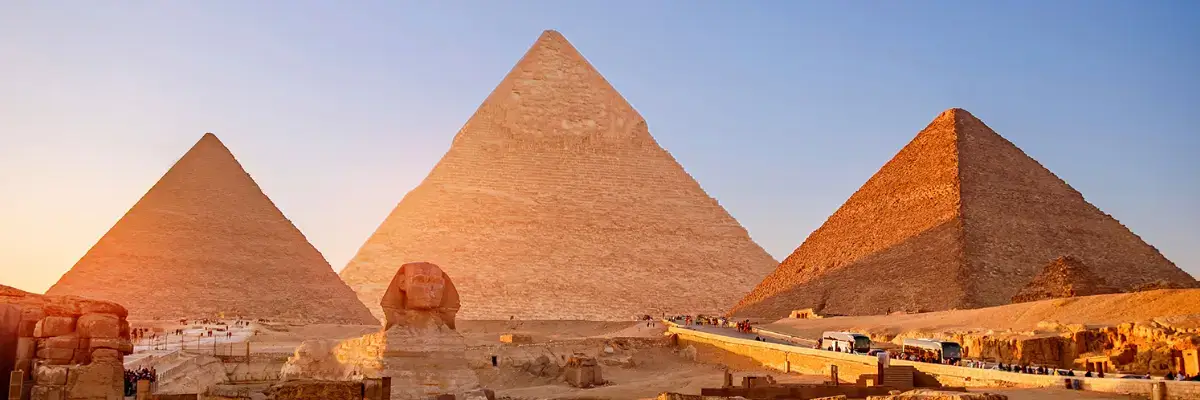
There are numerous theories as to what happened to the ancient Egyptians who built the Khafre Pyramid. As such, it is not surprising that the pyramid contains numerous secrets. The Khafre Pyramid is home to an array of secrets which was built by king chephren.
Visitors to the Khafre Pyramid can explore these secrets by exploring the pyramid’s interior. The interior of the pyramid is not as impressive as the exterior, but it does give you a chance to explore the Great Pyramid of Giza and its ancient function.
Inside the pyramid, you will find the burial chamber of Khufu, which does not reveal much about its original function. The interior of the pyramid, however, is intricately carved, and it is possible to explore the walls and ceiling. The pyramid is also home to the Sphinx.
The Sphinx is a massive statue of khafre that was carved out of limestone and is believed to have been erected during the dynasty of Old Kingdom, around 3,600 years ago. While the Sphinx does not have a roof, the Khafre Pyramid does. This roof was originally made of wood, but it has since been replaced by a metal roof. The metal roof has amazing inscriptions on it, which you can explore.
Practical Tips for Visiting the Pyramid
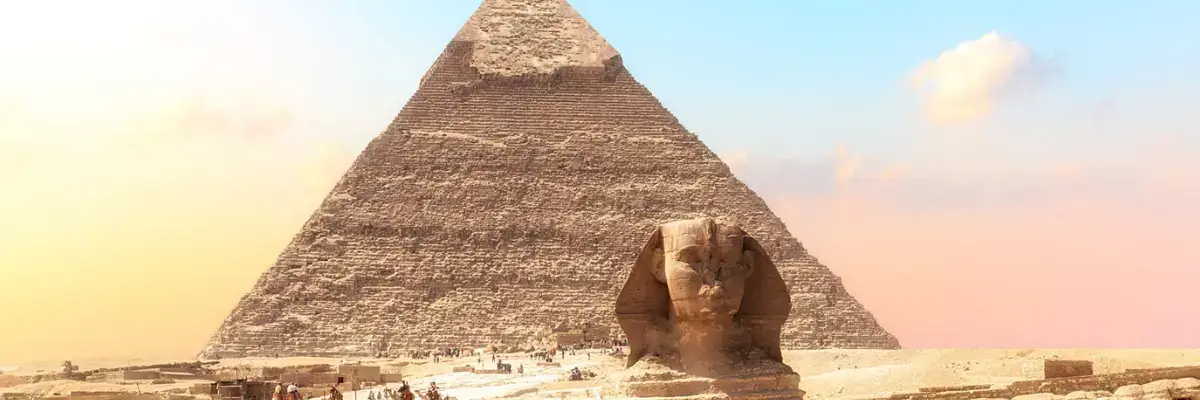
– Visit the Giza Pyramids – The Giza Pyramids are perhaps the most famous of the Ancient Egyptian structures and the Khafre Pyramid is no exception. Located to the east of the Great Pyramids in the Giza Pyramids, the Khafre Pyramid is located just 8 miles from the center of Cairo.
The Giza Pyramids are also a major tourist draw and offer visitors an excellent opportunity to explore many of the same attractions as the Khafre Pyramid, as well as visit the Great Pyramid of Khufu, the Great Sphinx, and the Great Pyramids of Khafre. – Visit the Great Pyramids of Giza – Located to the west of the Giza Pyramids, the Great Pyramids of Giza are the oldest and grandest of the Seven Ancient Wonders of the World.
Constructed sometime during the Old Kingdom, around 2500 BC, the Great Pyramids of Giza are amongst the oldest and largest examples of human architectural achievement.
The Museum of Egyptian Antiquities is perhaps the most famous of the museums in Cairo.
Located in the Cairo Citadel, the museum is home to a wealth of archaeological artifacts and artefacts from ancient Egypt. The Egyptian museum is an excellent opportunity to explore the culture and history of Ancient Egypt, as well as to learn more about the archaeological discoveries made by the Egyptians.
It is also worth noting that the museum is often a major tourist draw, so you may wish to visit as soon as you arrive in Cairo.
Explore the Old City
The Old City is home to numerous architectural wonders and offers visitors an opportunity to explore the ancient history of the city. The main attractions of the Old City are the Islamic Cairo Castles, the Citadel, the Khan el-Khalili Bazaar, and the Sufi Misk Ali Shrine.
Attend a Show – The Giza Pyramids are perhaps the most famous of the Ancient Egyptian structures and the Khafre Pyramid is no exception.
Attractions Near the Pyramid
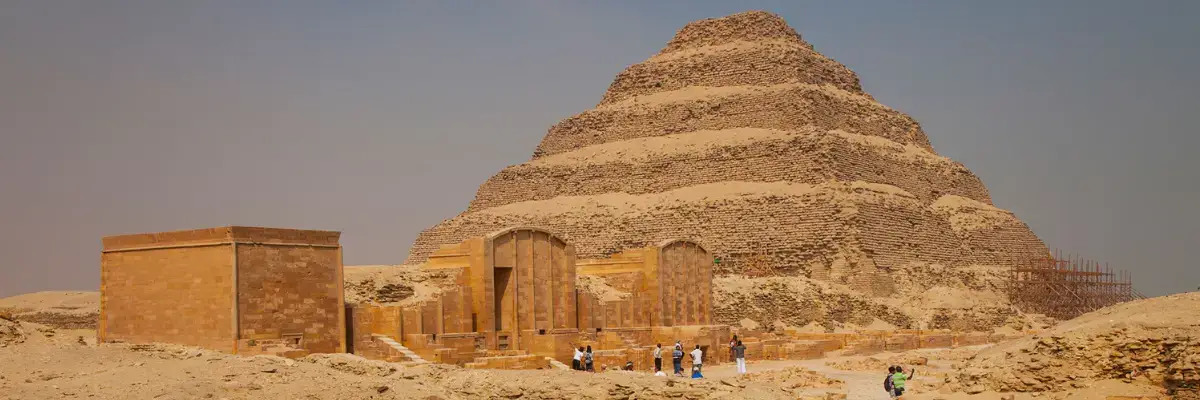
The Khafre Pyramid is located just 8 miles from the center of Cairo, and so it is easy to visit other attractions in the city while you are there. The Giza Pyramids are perhaps the most famous of the Ancient Egyptian structures, and are a major tourist draw. In addition to these, the Great Pyramids of Giza are also worth visiting, and the Pyramids of Saqqara, the Sphinx, and the Bent Pyramid are also worth a look.
The Best Cheap Tour Packages in Egypt
| Tour Name | Duration |
|---|---|
| The Best Egypt 14 Days Tour Itinerary | 14 Days – 13 Nights |
| Full Day Tour to Giza Pyramids Memphis and Sakkara | 1 Day |
| Giza Pyramids Day Tour | 1 Day |
| 6 Days Cairo and Hurghada Tour Package | 6 Days – 5 Nights |
Conclusion
The Khafre Pyramid is one of the most iconic structures of Ancient Egypt and is a sight to behold. The pyramid is located just 8 miles from the center of Cairo, and so it is easy to visit other attractions in the city while you are there. The pyramid is also home to numerous secrets and features an interesting interior, making it a worthwhile visit.
Exploring Khafre’s Pyramid: FAQ
What is the Khafre Pyramid?
The Khafre Pyramid is one of the three major pyramids in the Giza pyramid complex in Egypt. It’s the second tallest and second largest of the trio, built for Pharaoh Khafre, who ruled during the Fourth Dynasty.
How tall is the Khafre Pyramid?
Originally, the pyramid stood at 143.5 meters (471 feet). Over time, due to erosion and the loss of the outer casing stones, it’s now approximately 136 meters (446 feet).
How does the Khafre Pyramid differ from the Great Pyramid?
Though slightly shorter, Khafre’s Pyramid appears taller because it sits on higher ground. Unlike the Great Pyramid, Khafre’s has a portion of its outer casing still intact at the top, offering a glimpse of what all the pyramids once looked like.
Who was buried in the Khafre Pyramid?
The pyramid was constructed as the tomb for Pharaoh Khafre. Despite tomb robbers looting most of its treasures over the centuries, Khafre’s granite sarcophagus remains inside.
Are there any unique features of the Khafre Pyramid?
One distinctive feature is the temple complex connected to it, which includes a valley temple, a causeway, and a mortuary temple. The Great Sphinx, often associated with Khafre, stands nearby and is thought to be a part of the complex.
Can visitors enter the Khafre Pyramid?
Yes, visitors can enter the pyramid. The experience involves narrow passages and steep climbs, providing an insight into ancient architectural methods. However, access may be limited due to preservation efforts.
Why is the Khafre Pyramid important?
It’s a testament to ancient Egyptian engineering and architectural prowess. Studying it helps us understand the societal and religious values of ancient Egypt, especially during Khafre’s reign.
Is the Khafre Pyramid aligned with any celestial bodies?
Like many Egyptian pyramids, Khafre’s is aligned with precision to the cardinal points. This alignment reflects the Egyptians’ advanced understanding of astronomy.
What materials were used to build the Khafre Pyramid?
The core is made of limestone blocks, while the visible casing was originally highly polished Tura limestone, which gleamed brightly under the sun. Some granite was used in the inner chambers and temple complex.
How has the Khafre Pyramid survived for so long?
The pyramid’s survival is due to the sheer size of the blocks and the meticulous construction techniques. The arid climate of Egypt has also played a significant role in its preservation.


